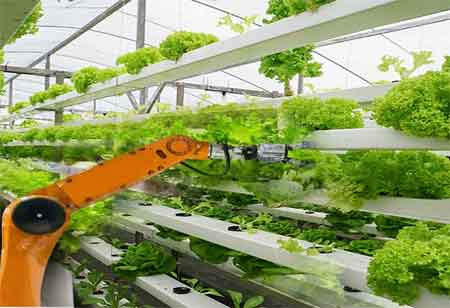Thank you for Subscribing to Agri Business Review Weekly Brief
A New Method to Improve Vertical Farming
A recent method introduced cultivating fresh produce in an artificial environment looking like a tall, metal-clad barn.

By
Agri Business Review | Tuesday, November 29, 2022
Stay ahead of the industry with exclusive feature stories on the top companies, expert insights and the latest news delivered straight to your inbox. Subscribe today.
Vertical farming provides more fresh produce to people, and as these systems improve further, miniature versions are designed, proving that LED lights can help produce yields.
FREMONT, CA: A recent method introduced cultivating fresh produce in an artificial environment looking like a tall, metal-clad barn. It has a large airlock designed to keep out the bugs, and a kaleidoscopic scene emerges. A central aisle is flanked by two pairs of towers stacked with a dozen or so plant-growing trays. Each tray has vibrant lights, such as blue and magenta.
The nine-metre-high towers in the demonstration unit occupy barely 40 square metres. However, by stacking the trays one on top of another, a single tower provides up to 350 square metres of growing area. An app built for changing the colours and brightness of the LEDs is strung out above each tray. This app can control the temperature, humidity, and ventilation, and the hydroponic system supplies the plants growing on various non-soil substrates with water and nutrients.
This type of vertical farming is not a new experiment. Although it was present a century ago, it took a long time for the first commercial vertical farms to be built. However, the business is now taking off. Many organisations invest in vertical-farming businesses to grow fresh produce within their automated distribution depots.
The interest of investors is increasing as technology promises to turn vertical farming operations into efficient plant factories. The demonstration unit's high-tech LEDs reduce photon waste. The hydroponics and recycling supporting them indicate that the only water lost from the system is that which ends up as part of one of the plants. Furthermore, towers mean the system is modular and can be scaled up. Most systems hoping to start delivering to customers early will consist of ten or more towers.
However, there are concerns about how much vertical farms can provide that traditional greenhouses cannot. Vertical farms are more compact or advantageous in cities where land is expensive. Fresh produce sales to the urban masses are often touted as one of vertical farming’s greatest opportunities. However, the greenhouse gets its light and heat free from the sun. Furthermore, solar-powered additional LED lighting and hydroponic systems help modern greenhouses to extend growing seasons and reduce water usage.
A significant drawback of vertical farming is the high cost of the electricity required to run many LEDs. This has highlighted the fact that production has been commercially viable for high-value, perishable produce such as leaves and herbs. This is expensive for a broader range of products. Vertical farming will not feed the world but will provide more fresh produce to more people. As vertical farming systems improve, more miniature versions will be designed.





